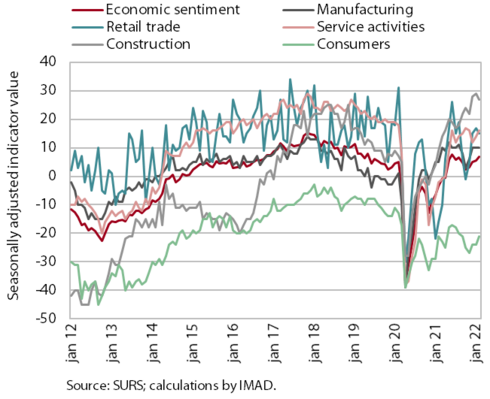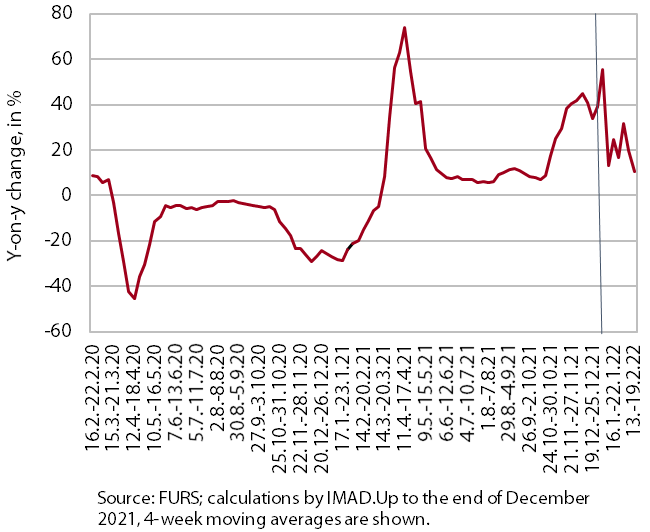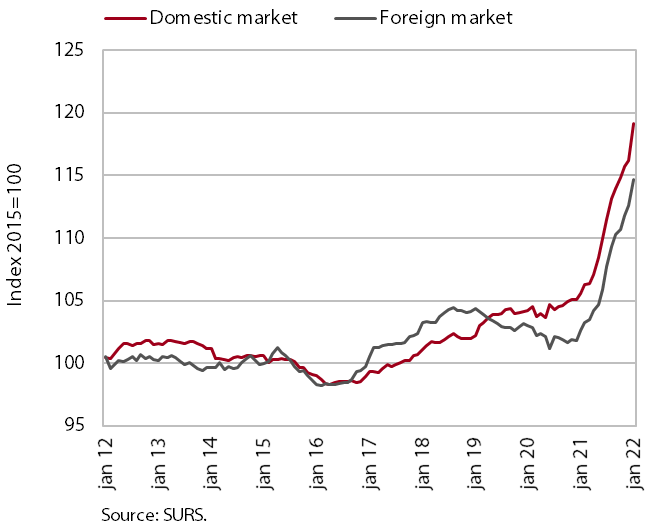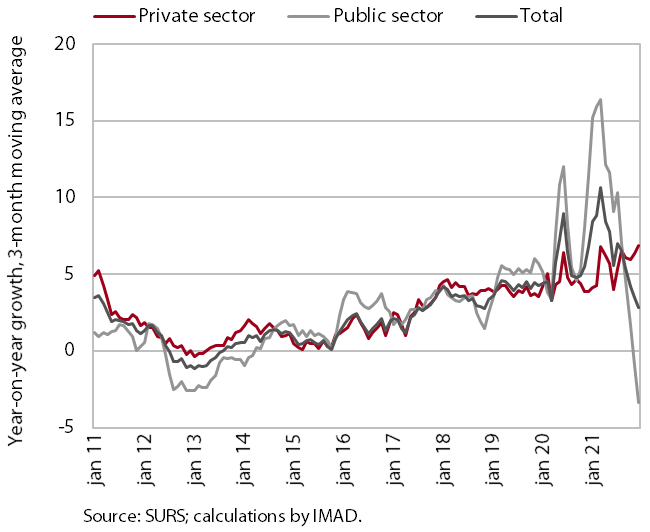Charts of the Week
Current economic trends from 21 to 25 February 2022: economic sentiment, turnover based on fiscal verification of invoices, Slovenian industrial producer prices and other data
The economic sentiment indicator rose in February. Confidence in all sectors was significantly higher than a year ago, while it remained unchanged among consumers. The Ukrainian crisis is not yet reflected in the indicator value for February. According to data on fiscal verification of invoices, total turnover until mid-February was higher year-on-year, reflecting higher turnover in trade, while turnover in accommodation and food service activities and creative, arts and entertainment activities and personal services remained lower. The high level of economic activity and the continued tight conditions in energy markets have led to an increase in Slovenian industrial producer prices, which reached their highest level in 20 years in January. Over the past year, average wages increased by 6.1% in nominal terms, as did average wages in the private sector, while in the public sector they rose by 6.5%. Wage growth in the public sector slowed in the second half of the year due to the cessation of epidemic-related bonus payments, while growth in the private sector continued.
Economic sentiment, February 2022

The economic sentiment indicator rose in February. At the monthly level, confidence improved among consumers, in manufacturing and service activities. Confidence in all sectors was significantly higher in February than a year ago, while it remained unchanged among consumers. Confidence was also higher than in February 2020, but only owing to higher indicators in construction and manufacturing, while other indicators remained lower due to the measures to contain the spread of the epidemic. Possible factors limiting the rise in indicators in manufacturing are the current situation in the international environment (supply bottlenecks and rising commodity and energy prices), while the deterioration in retail trade and among consumers is related to the ongoing uncertainty about the epidemiological situation and containment measures, as well as rising prices.
Turnover based on fiscal verification of invoices, 6–19 February 2022

According to data on the fiscal verification of invoices, total turnover between 6 and 19 February 2022 was 15% higher year-on-year in nominal terms and 2% higher than in the same period of 2020. Year-on-year growth was lower than in the previous two weeks, mainly due to a partial relaxation of operating restrictions in February last year. This was mainly reflected in lower year-on-year turnover growth in trade (7%). However, year-on-year growth was still very high for activities that were almost completely shut down in the same period of 2021 – mainly tourism-related services. Amid higher prices, total turnover was 2% higher in nominal terms than in the same period of 2020, reflecting higher turnover in trade; turnover in accommodation and food service activities and creative, arts and entertainment activities and personal services remained lower.
Slovenian industrial producer prices, January 2022

The high level of economic activity and the persistently tense situation on the energy markets have led to a 12.3% increase in Slovenian industrial producer prices in January, the highest level in 20 years. Prices in the domestic market rose (12.8% year-on-year) at a slightly faster pace than prices in foreign markets (11.7%). Prices were higher in all industrial groups. According to our estimates, the higher overall growth was mainly due to the 18.5% year-on-year increase in prices in the intermediate goods group. The price growth in the energy group also strengthened slightly (to 11.8% year-on-year), but was significantly lower than in euro area, where it was above 75% at the end of last year. Higher prices for raw materials and other inputs are also affecting the growth of consumer goods prices, which are rising the slowest of all product groups, increasing by almost 5% year-on-year in January. Prices of semi-durable goods are rising slightly faster than prices of non-durable goods.
Wages, December 2021

In December 2021, average wages in the public sector were 6.3% lower year-on-year, while they were 7.8% higher in the private sector. Due to the cessation of the majority of epidemic-related bonus payments, year-on-year wage growth in the public sector slowed significantly in the second half of last year and already turned negative in December. In 2021 as a whole, these wages were 6.5% higher than in 2020. In the private sector, average wages increased by 6.1% in 2021, mainly due to the impact of the minimum wage increase at the beginning of the year, but also to the return to employment of workers who had participated in job retention measures. The increase in year-on-year private sector wage growth in November and December last year was also influenced by extraordinary payments (13th salaries and Christmas bonuses), which were higher than in the same periods of 2020 and 2019 given the good performance of companies. According to our estimates, wage growth in some private sector activities (manufacturing, construction and accommodation and food service activities) is already being affected by labour shortages. Overall, average wages rose by 6.1% last year.
